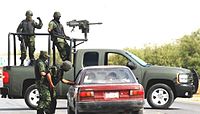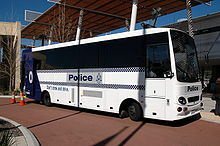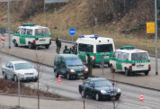- Random checkpoint
-
A random checkpoint (also known as a "flying checkpoint", "mobile checkpoint" or "hasty checkpoint") is a military and police tactic involving the set up of a hasty roadblock primarily by mobile truck-mounted infantry or police units in order to disrupt unauthorized or unwanted movement and/or military activity.[1]
Random checkpoints are set up to achieve surprise, as opposed to known permanently located manned checkpoints. They might be established in locations where they cannot be observed by approaching traffic until it is too late to withdraw and escape without being observed.[2]
Contents
Overview
The unit establishing the checkpoint must carry the materials necessary to construct it. It might use a vehicle, or multiple vehicles, reinforced with concertina wire, or other objects as the main obstacle. The vehicles might be positioned to partially or entirely block the road or route. The search area might be the space between multiple vehicles. Sentries might be positioned at each end of the checkpoint and are covered by mounted or dismounted automatic weapon positions. A reaction force may be designated and concealed nearby.[2]
Vehicular and pedestrian traffic that approach with the intent of passing flying checkpoints can be asked to produce identification and submit to a search of their persons and/or vehicle. In some cases, people without proper identification or who arouse suspicion may be refused passage, detained, or arrested. Contraband may be confiscated.[3] A random checkpoint must be functional within 15 minutes of the unit's arrival on-site, and establish security teams 50-100 meters on both side of the area to be controlled. Advanced observation posts may also be positioned further out, if desired.[3] When large geographical areas need to be monitored, the checkpoint may be quickly airlifted by helicopter from one location to another.[4]
Flying roadblocks and checkpoints are usually established for no more than a few hours, in order to decrease the possibility of insurgent attacks on them, as well as to maintain their effectiveness as a surprising, unexpected obstacle.[5]
Random checkpoints are a common tactic used by many military and police forces, and have been recently used by UN forces in Kosovo, Lebanese militias in Beirut,[6] The Israeli army in the West Bank[7] and US forces in Kurdistan,[8] and Iraq in search of insurgents, fugitives, and other law breakers. In some war zones these checkpoints can heave lethal consequences. This is especially true in the case of suicide blasts which produce casualties regardless of political or cultural affiliation.
Sobriety checkpoints
Sobriety checkpoints or roadblocks involve law enforcement officials stopping every vehicle (or more typically, every nth vehicle) on a public roadway and investigating the possibility that the driver might be too impaired to drive. They are often set up late at night or in the very early morning hours and on weekends, at which time the proportion of impaired drivers tends to be the highest.
With a portable and quick alcohol breath test, the police can test all drivers (if the law permits), and process the cars one by one as in a conveyor belt. When there is no quick test, a more complicated routine is necessary. Upon suspicion, the stopped driver is required to exit the vehicle and take a roadside sobriety test that requires the demonstration of both mental and balance skills. If the officer determines that the test has not been passed, the driver is then required to take an alcohol breath test (referred to as a Breathalyzer test in the United States).
Sobriety checkpoints regularly catch much more than just drunk drivers. The identity checks will catch individuals wanted by the police, and DUI often occurs together with other crimes, such as vehicle inspection and registration violations, vehicle tax avoidance or driving without a license.
Australia
In Australia, drivers may be stopped at any point along any road by a police officer for a "random breath test", commonly referred to as an "RBT".[9] For an operation involving a large number of police (typically 10-20) at a fixed location, the colloquial term "booze bus" is often used. In all states, the maximum BAC of 0.05% is enforced.[10] Drivers who are found to have a preliminary reading of greater than 0.05% are required to wait for a 15 minute period, after which time they are retested.[citation needed]
In Victoria and New South Wales the concept has been extended to make sobriety checkpoints also "drug buses" (or dual buses), capable of testing drivers for a number of illicit drugs including cannabis (tetrahydrocannabinol), methamphetamine, and ecstasy (MDMA).[11]
United States of America
Legality in the United States
The Fourth Amendment to the United States Constitution states that: “The right of the people to be secure in their persons, houses, papers, and effects, against unreasonable searches and seizures, shall not be violated, and no Warrants shall issue, but upon probable cause, supported by Oath or affirmation, and particularly describing the place to be searched, and the persons or things to be seized.” At a sobriety checkpoint, drivers are necessarily stopped without reasonable suspicion, and may be tested summarily and without probable cause. Thus the Constitution would appear to prohibit people from being stopped without a search warrant or at least without probable cause that they have committed a crime; however, the warrant requirement only attaches should the search be unreasonable and the Supreme Court, as shown below, decided that such stops are not unreasonable under certain circumstances.
Driving under the Influence of alcohol is a special type of crime, as driving with a blood alcohol content (BAC) over a set limit is defined as the crime; it is not necessary to drive recklessly or cause an accident in order to be convicted. To determine BAC accurately, it is generally necessary for the driver to subject themselves to tests that are self incriminating, and drivers sometimes exercise their right against self incrimination to refuse these tests. To discourage this, some jurisdictions set the legal penalties for refusing a BAC test to equal or worse than those for a failing a BAC test. In other jurisdictions, the legal system may consider refusing the roadside alcohol breath test to be probable cause, allowing police to arrest the driver and conduct an involuntary BAC test. The Michigan Supreme Court had found sobriety roadblocks to be a violation of the Fourth Amendment. However, by a 6-3 decision in Michigan Dept. of State Police v. Sitz (1990), the United States Supreme Court found properly conducted sobriety checkpoints to be constitutional. While acknowledging that such checkpoints infringed on a constitutional right, Chief Justice Rehnquist argued the state interest in reducing drunk driving outweighed this minor infringement.
Dissenting justices argued that the Constitution doesn’t provide exceptions. "That stopping every car might make it easier to prevent drunken driving...is an insufficient justification for abandoning the requirement of individualized suspicion", dissenting Justice Brennan insisted.
Chief Justice Rehnquist argued that an exception was justified because sobriety roadblocks were effective and necessary. On the other hand, dissenting Justice Stevens countered that "the findings of the trial court, based on an extensive record and affirmed by the Michigan Court of Appeals, indicate that the net effect of sobriety checkpoints on traffic safety is infinitesimal and possibly negative."
Jurisdictions that allow sobriety checkpoints often carve out specific exceptions to their normal civil protections, in order to allow sobriety checkpoints. Although the U.S. Supreme Court has found sobriety checkpoints to be constitutionally permissible, ten states (Idaho, Iowa, Michigan, Minnesota, Oregon, Rhode Island, Texas, Washington, Wisconsin, and Wyoming) have found that sobriety roadblocks violate their own state constitutions or have outlawed them.[12] Two other states (Alaska and Montana) do not use checkpoints even though they have not made them illegal. [13]
Legal guidelines for checkpoint procedures
In approving "properly conducted" checkpoints, Chief Justice Rehnquist implicitly acknowledged that there must be guidelines in order to avoid becoming overly intrusive. In other words, checkpoints cannot simply be set up when, where and how police officers choose. As often happens in Supreme Court decisions, however, the Chief Justice left it to the states to determine what those minimal safeguards must be, presumably to be reviewed by the courts on a case-by-case basis.
In an effort to provide standards for use by the states, the National Highway Traffic Safety Administration subsequently issued a report that reviewed recommended checkpoint procedures in keeping with federal and state legal decisions. ("The Use of Sobriety Checkpoints for Impaired Driving Enforcement", DOT HS-807-656, Nov. 1990) An additional source of guidelines can be found in an earlier decision by the California Supreme Court (Ingersoll v. Palmer (43 Cal.3d 1321 (1987)) wherein the Court set forth what it felt to be necessary standards in planning and administering a sobriety checkpoint:
- Decision making must be at a supervisory level, rather than by officers in the field.
- A neutral formula must be used to select vehicles to be stopped, such as every vehicle or every third vehicle, rather than leaving it up the officer in the field.
- Primary consideration must be given to public and officer safety.
- The site should be selected by policy-making officials, based upon areas having a high incidence of drunk driving.
- Limitations on when the checkpoint is to be conducted and for how long, bearing in mind both effectiveness and intrusiveness.
- Warning lights and signs should be clearly visible.
- Length of detention of motorists should be minimized.
- Advance publicity is necessary to reduce the intrusiveness of the checkpoint and increase its deterrent effect.
Effectiveness
The Centers for Disease Control, in a 2002 Traffic Injury Prevention report, found that in general, the number of alcohol related crashes was reduced by 20% in states that implement sobriety checkpoints compared to those that do not.[14]
Public Health Law Research, an independent organization, reported in a 2009 evidence brief summarizing the research assessing the effect of a specific law or policy on public health, that there is strong evidence supporting the effectiveness of selective breath testing sobriety checkpoints as a public health intervention aimed at reducing the harms associated with alcohol impaired driving.[15]
The debate regarding saturation patrols versus checkpoints favors saturation patrols being more effective, both in terms of number of arrests and cost. The FBI compared saturation patrols vs. checkpoints in Ohio, Missouri, and Tennessee. The study showed that, “Overall, measured in arrests per hour, a dedicated saturation patrol is the most effective method of apprehending offenders.”[16] Another survey found that "States with infrequent checkpoints claimed a lack of funding and police resources for not conducting more checkpoints, preferred saturation patrols over checkpoints because they were more 'productive,' and used large number of police officers at checkpoints."[17]
There is a dearth of research regarding the deterrent effect of checkpoints. The only formally documented research regarding deterrence is a survey of Maryland's "Checkpoint Strikeforce" program. The survey found no deterrent effect: "To date, there is no evidence to indicate that this campaign, which involves a number of sobriety checkpoints and media activities to promote these efforts, has had any impact on public perceptions, driver behaviors, or alcohol-related motor vehicle crashes and injuries. This conclusion is drawn after examining statistics for alcohol-related crashes, police citations for impaired driving, and public perceptions of alcohol-impaired driving risk."[18]
See also
References
- ^ "Checkpoints". GlobalSecurity.org. http://www.globalsecurity.org/military/library/report/call/call_93-8_chap9.htm. Retrieved 05.12.2007.
- ^ a b UN Checkpoint operations
- ^ a b Guide to Military Operations Other Than War: Tactics, Techniques, and Procedures for Stability & Support Operations, Keith Earle Bonn, Anthony E. Baker, p.113-115
- ^ Afghan Allies Hunt Assassins CNN, July 8, 2002
- ^ Population and Resources Control
- ^ Thomas Friedman (17 July 1983). "Living with the violence of Beirut". New York Times. http://query.nytimes.com/gst/fullpage.html?res=9806E1D61539F934A25754C0A965948260&sec=health&spon=&pagewanted=4. Retrieved 2007-05-24.
- ^ "Israel, An Alleged State of Democracy". Applied Research Institute Jerusalem (ARIJ). 25 April 2007. http://www.poica.org/editor/case_studies/view.php?recordID=1054. Retrieved 05.12.2007.
- ^ "Tactics, Techniques and Procedures in Operations Other than War". GlobalSecurity.org. http://www.globalsecurity.org/military/library/report/1994/call-haiti-94-3_chp3.htm. Retrieved 2007-05-29.
- ^ NSW Centre for road safety NSW.gov.au
- ^ Australian Federal Police AFP.gov.au
- ^ Natalie Webster (Media Officer), 7 December 2007. "Victoria Police - Full dual bus contingent launched". Victoria Police, Retrieved on August 1, 2009
- ^ http://www.raleighdurhamlaw.com/dui-checkpoints/
- ^ http://www.madd.org/laws/law-overview/Sobriety_Checkpoints_Overview.pdf
- ^ Research Update: Sobriety Checkpoints Are Effective in Reducing Alcohol-Related Crashes
- ^ Selective Breath Testing Sobriety Checkpoints
- ^ Greene, Jeffrey W., 2003. Battling DUI: A Comparative Analysis of Checkpoints and Saturation Patrols. FBI Law Enforcement Bulletin, 72: 1-6.
- ^ Fell, J.C., Ferguson, S.A., Williams, A.F., 2003. Why are sobriety checkpoints not widely adopted as an enforcement strategy in the United States? Accident Analysis and Prevention, 35: 897-902.
- ^ Beck, Kenneth, 2009. Lessons Learned From Evaluating Maryland's Anti-Drunk Driving Campaign: Assessing the Evidence for Cognitive, Behavioral, and Public Health Impact. Health Promotion Practice, 10: 370-377.
Further reading
- Mothers Against Drunk Driving. Sobriety Checkpoints: Facts and Myths. Mothers Against Drunk Driving website, September 11, 2005..
- Ross, H. L. Confronting Drunk Driving. New Haven, CT: Yale University Press, 1992.
- Simpson, H. M., and Mayhew, D. R. The Hard Core Drinking Driver. Ottawa, Ontario, Canada: Traffic Safety Research Foundation, 1991.
- Taylor, L. Drunk Driving Defense. New York: Aspen Law and Business, 6th edition, 2006.
External links
Categories:- Military tactics
- Law enforcement techniques
- Checkpoints
- Drunk driving
Wikimedia Foundation. 2010.




